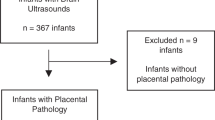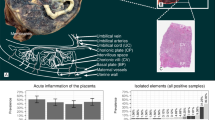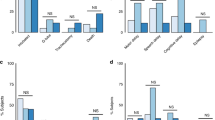Abstract
OBJECTIVE:
To test the hypothesis that histological chorioamnionitis (CA) is not associated with increased risk of early onset intraventricular hemorrhage (IVH).
STUDY DESIGN:
Clinical data were prospectively collected for 62 consecutive neonates born before 28 weeks of gestation. Placental histology for CA was performed by a pathologist unaware of the head ultrasound scan (HUS) results. The first HUS was obtained by 30 minutes of life. Follow-up HUS were performed before 24 hours and again at 48 to 72 postnatal hours of life. An IVH (grade I to IV) at less than 72 hours of life was deemed an early hemorrhage.
RESULTS:
Nine of the 62 (14.5%) infants had early onset IVH. In all, 29 infants were born to women with histological evidence of CA; 33 infants did not have CA. Infants did not differ in birth weight, gestational age, sex, cord blood pH, 5-minute Apgar score of <7, cesarean delivery, prenatal use of steroids, administration of tocolytics, need for resuscitation, presence of pneumothorax, platelet count at birth, or use of surfactant. Early IVH rates (3/29 in CA vs 6/33 in non-CA) were similar (p=0.48). Two infants in each group with early IVH died before 2 weeks of age. Five additional infants from the CA group developed IVH at more than 72 postnatal hours of life (late onset IVH), and two of those infants progressed to develop periventricular leukomalacia (PVL). In contrast, only three non-CA infants had late IVH and none developed PVL. Logistic regression confirmed that no perinatal variables including CA were associated with early onset IVH.
CONCLUSION:
Chorioamnionitis is not associated with increased risk of early IVH.
This is a preview of subscription content, access via your institution
Access options
Subscribe to this journal
Receive 12 print issues and online access
$259.00 per year
only $21.58 per issue
Buy this article
- Purchase on Springer Link
- Instant access to full article PDF
Prices may be subject to local taxes which are calculated during checkout
Similar content being viewed by others

References
Salafia CM, Minior VK, Rosenkrantz TS, et al. Maternal, placental and neonatal associations with early germinal matrix/intraventricular hemorrhage in infants born before 32 weeks gestation. Am J Perinatol 1995;12:429–436.
Dammann O, Leviton A . Maternal intrauterine infection, cytokines, and brain damage in the preterm newborn. Pediatr Res 1997;42:1–8.
Verma U, Tejani N, Klein S, et al. Obstetric antecedents of intraventricular hemorrhage and periventricular leucomalacia in the low-birth-weight neonate. Am J Obstet Gynecol 1997;176:275–281.
Weeks JW, Reynolds L, Taylor D, Lewis J, Wan T, Gall SA . Umbilical cord blood interleukin-6 levels and neonatal morbidity. Obstet Gynecol 1997;90:815–818.
Gomez R, Romero R, Ghezzi F, Yoon BH, Mazor M, Berry SM . The fetal inflammatory response syndrome. Am J Obstet Gynecol 1998;179:194–202.
Vergani P, Patanè L, Doria P, et al. Risk Factors for Neonatal Intraventricular Haemorrhage in Spontaneous Prematurity at 32 Weeks Gestation or Less. Placenta 2000;21:402–407.
Wells JT, Ment LR . Prevention of intraventricular hemorrhage in preterm infants. Early Hum Dev 1995;42:209–233.
Redline RW, Faye-Petersen O, Heller D, Qureshi F, Savell V, Vogler C . Amniotic infection syndrome: nosology and reproducibility of placental reaction patterns. Pediatr Dev Pathol 2003;6:435–448.
Burdjalov V, Srinivasan P, Baumgart S, Spitzer AR . Handheld, portable ultrasound in the neonatal intensive care nursery: a new, inexpensive tool for the rapid diagnosis of common neonatal problems. J Perinatol 2002;22:478–483.
Volpe JJ . Intracranial hemorrhage. In: Volpe JJ, editor. Neurology of the Newborn. Philadelphia: WB Saunders Company; 2000, p. 428–493.
Toti P, De Felice C . Chorioamnionitis and Fetal/Neonatal Brain Injury. Biol Neonate 2001;79:201–204.
Dammann O, Leviton A . Infection remote from the brain, neonatal white matter damage, and cerebral palsy in the preterm infant. Semin Pediatr Neurol 1998;5:190–201.
Heep A, Behrendt D, Nitsch P, Fimmers R, Bartmann P, Dembinski J . Increased serum levels of interleukin 6 are associated with severe intraventricular hemorrhage in extremely premature infants. Arch Dis Child Fetal Neonatal Ed 2003;88:F501–F504.
DeFelice C, Toti P, Laurini RN, et al. Early neonatal brain injury in histological chorioamnionitis. J Pediatr 2001;138:101–103.
Yoon BH, Romero R, Park JS, et al. The relationship among inflammatory lesions of the umbilical cord (funisitis), umbilical cord plasma interleukin-6 concentration, amniotic fluid infection, and neonatal sepsis. Am J Obstet Gynecol 2000;183:1124–1129.
Groneck P, Tauscher M, Stiller S, et al. Association of chorioamnionitis, increased levels of cord blood cytokines and intracerebral hemorrhage in preterm neonates (abstract). Pediatr Res 1999;45:910A.
Yoon BH, Jun JK, Romero R, et al. Amniotic fluid inflammatory cytokines (interleukin-6, interleukin-1β, and tumor necrosis factor-α), neonatal brain white matter lesions, and cerebral palsy. Am J Obstet Gynecol 1997;177:19–26.
Mercer BM, Aheart KL . Antimicrobial therapy in expectant management of preterm premature rupture of the membranes. Lancet 1995;346:1271–1279.
Egarter C, Leitich H, Karas H, et al. Antibiotic treatment in preterm premature rupture of membranes and neonatal morbidity: a metaanalysis. Am J Obstet Gynecol 1996;174:589–597.
De Reuck JL . Cerebral angioarchitecture and perinatal brain lesions in premature and full-term infants. Acta Neurol Scand 1984;70:391–395.
Lou HC . The “lost autoregulation hypothesis” and brain lesions in the newborn—an update. Brain Dev 1988;10:143–146.
Kallapur SG, Kramer BW, Moss TJ, et al. Maternal glucocorticoids increase endotoxin-induced lung inflammation in preterm lambs. Am J Physiol Lung Cell Mol Physiol 2003;284:633–642.
Groothuis AM, de Kleine MJ, Oei SG . Intraventricular haemorrhage in utero. A case-report and review of the literature. Eur J Obstet Gynecol Reprod Biol 2000;89:207–211.
Acknowledgements
We acknowledge the valuable contribution of Ronald E. Dechert, DRPH from Critical Care Support Services, University of Michigan, Ann Arbor for assistance in Statistical analysis.
Author information
Authors and Affiliations
Rights and permissions
About this article
Cite this article
Sarkar, S., Kaplan, C., Wiswell, T. et al. Histological Chorioamnionitis and the Risk of Early Intraventricular Hemorrhage in Infants Born ≤28 Weeks Gestation. J Perinatol 25, 749–752 (2005). https://doi.org/10.1038/sj.jp.7211399
Published:
Issue Date:
DOI: https://doi.org/10.1038/sj.jp.7211399
This article is cited by
-
The influence of chorioamnionitis on respiratory drive and spontaneous breathing of premature infants at birth: a narrative review
European Journal of Pediatrics (2024)
-
Establishment and evaluation of nomogram for predicting intraventricular hemorrhage in neonatal acute respiratory distress syndrome
BMC Pediatrics (2023)
-
Placental pathology and intraventricular hemorrhage in preterm and small for gestational age infants
Journal of Perinatology (2021)
-
Pathological staging of chorioamnionitis contributes to complications in preterm infants
Italian Journal of Pediatrics (2020)
-
Time-to-event analysis of surgically treated posthemorrhagic hydrocephalus in preterm infants: a single-institution retrospective study
Child's Nervous System (2017)


